| Columns Retired Columns & Blogs |
Thank you.
An instant classic review!!!
Another touch I appreciated was the option to install metal spikes or rubber feet—rigid metal for more bass, softer rubber for, presumably, more definition and perhaps a little bit less bass (footnote 2). I started with the metal spikes and felt, first, that I didn't have too much bass—the speakers are placed far from walls—and second, that the definition was just fine. I kept the spikes.
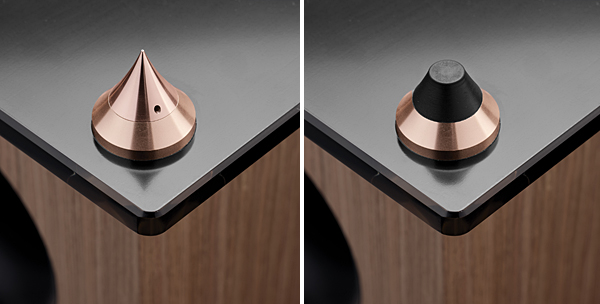
Triangle recommends a listening positioning at least 2m (6.6') from the midpoint between the speakers, with about 1.5' of space between the speakers and walls. The manual also offers a tip that sounded to me like one of those basic rules we learn early on but need to be reminded of every so often: The closer the speakers are to the front wall, the better the bass output, but also the less wide and deep the soundstage will be. (Especially deep.) As always with a democratic hobby such as ours, it's up to the listener to choose a happy medium.
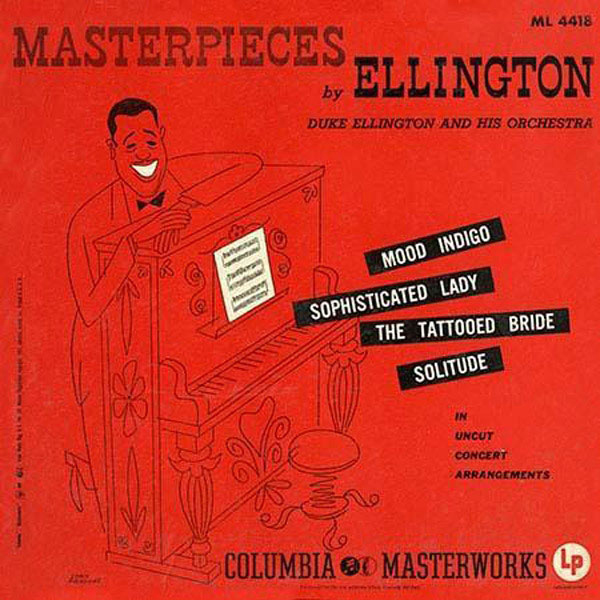
Immediately after I'd finished positioning the speakers, using Duke Ellington's monophonic Masterpieces by Ellington (CD, Columbia CK 87043) to lock in the central image, I noted two things. First, that the central image remained tight and focused even when I tilted my head off axis—a big sweet spot, then. Second, I noticed that the speakers' surfaces looked like the crime scene of a slam-dunk criminal case, coated in the glistening grease of fingerprints. I grabbed one of those dainty 40th Anniversary cleaning cloths—the ones I said were too pretty to use—and got straight to work rubbing out all evidence that I'd ever met those speakers. It wasn't me; I didn't do it.
The Antal 40th Anniversary Edition is a biwirable, front-ported, four-driver, three-way design. With a specified sensitivity of 92dB/m and a nominal 8 ohm impedance, I expected the Triangles to be easy to drive, including with my 37Wpc Grandinote Shinai integrated. It was, at least at volumes below the pain threshold, where I prefer to listen.
L'écoute
By my third day of listening, my first impression of the Triangles—that they possibly lacked some bass bloom and had an expressive midrange—was replaced with a more nuanced, better-informed understanding of the speakers' character. Was this reassessment a case of product habituation? Final break-in? A squirt of this, a dash of that? You tell me. All I know is that the following comments reflect listening that began in earnest on day 3.
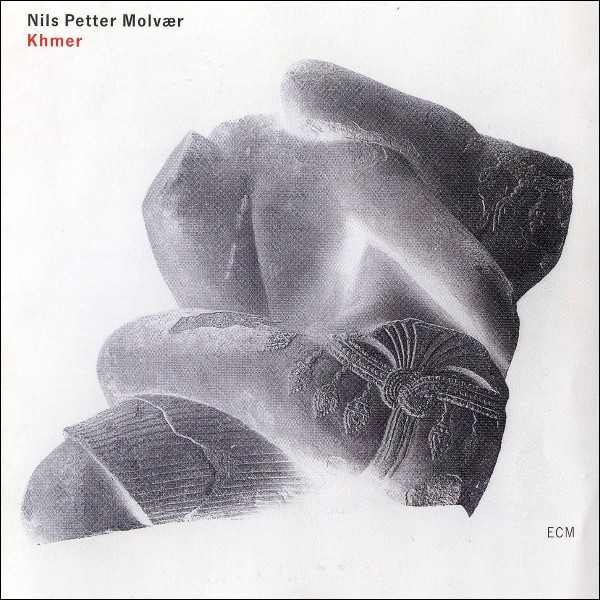
I relistened to Norwegian trumpetist Nils Petter Molvær's Middle East–infused album Khmer, a 1997 ECM recording whose fusion of jazz and electronica was unheard of at the time at ECM (CD, ECM 1560 537 798-2). Soundwise, it's an ECM recording: airy and spacious, uncompressed, with some added reverb but otherwise a bit dry, with realistic timbres, all traits the Triangles seemed to accentuate.
Well, yes and no. They did and they didn't accentuate those traits. The Antals didn't, I eventually concluded, exaggerate anything. Rather, they bared the midriff, so to speak, bringing midriff—midrange—sounds into focus. Even the smaller, secondary sounds, the hardly noticeable stuff, had a transiently tactile corporeality.
The repeated fragment of panned dulcimer at the beginning of the title track appeared to pluck the air in front of me. Molvær's trumpet sound was a morphing amalgam of air, metal, shape. It gesticulated. I could peer into its sinewy, shifting shapes, see the subtle sonic contours of its twisting-in-the-wind tones. The rushing breath exiting the trumpet's bell had sandpaper texture. What struck me most was the way the trumpet's sound spread like a spilled drink across the sky, flooding it.
The Antals imbued the midrange with a projector-like clarity against which images and musical lines appeared in physical, protuberant relief. The Triangles revealed gobs of detail but never threw them at me. They were also oh, so transparent. It was the first time I recalled being drawn to the sound of a percussive instrument beating softly from the left speaker at precisely the same time as a louder and previously overpowering one is beating from the right.
Hits from the bass drum were clean yet bold, with good impact and sustain. They may not have moved the air like my Focals but nor did they have the slight bass overhang of said Focals powered by the Shinai. The double bass booms seemed lobbed from some unknown source, off screen. I heard no telltale vestiges tying them to the Triangles' cabinets. But the Focals' slight midbass warmth could also make the Triangles, fed by the same amp, sound a tad overdamped.
Across Khmer, I consistently heard solid imaging and natural timbres. The Antals delivered an expansive, spherelike soundstage, throughout which sounds suddenly popped in or slid along the circular periphery of a multilevel 3D environment. This was no simple wide and deep soundstage; this was orbital. But wide and deep it was, as well. I heard sounds, mostly studio effects, stretch out beyond the speakers' sides by as much as 4'.
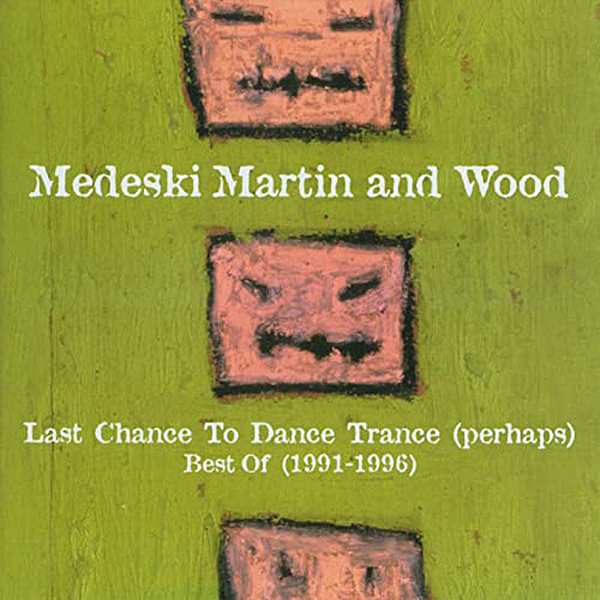
The Antals' transparency was also notable on "Chubb Sub" from Medeski Martin & Wood's Last Chance to Dance Trance (perhaps): Best of (1991-1996) compilation (CD, Gramavision GCD 79520). This track is a bass-thrashing juggernaut of three enmeshed instruments—organ, double bass, and drum—that seem to have been recorded one on top of the other to give the music an unstoppable barreling-down momentum. In my mind the sound also had a cartoon corollary: the amorphous dust cloud surrounding Peanuts' Pig-Pen, only now there was less dust in that cloud and more light. The Triangles didn't quite replicate the image height or the bulging, air-chuffing beat of the Focals, but they did, in exchange, offer slightly clearer sightlines into the paths charted by each instrument. Musical storylines were abundant. Double bass notes wove dexterously through the melee. Organ notes beamed with color and kept their composure despite their manic pace. The hi-hat took its place amid the percussive jungle. There was a lot going on, but it wasn't messy. There was that midrange focus again, lit up and orderly.
The title track showed again how even small sounds stand their ground, jutting out from the background fully formed. Chris Wood's rapid finger plucks on his double bass had amplified flapping-hummingbird tactility, his fingertips visibly shaped by the soundwaves that shaped them, images bathed in harmonic structure. The notes in Medeski's spiraling romps were each distinct and accounted for.
When, later in the song, Medeski's organ has given way to a piano, the piano sounded nothing like the organ. It shouldn't, of course, and usually doesn't, but here the timbres that differentiate them sounded particularly pronounced. Was all this intense timbre and transparency effect—this heightened see- and hear-through quality—validation of Triangle's proprietary midrange paper membrane?
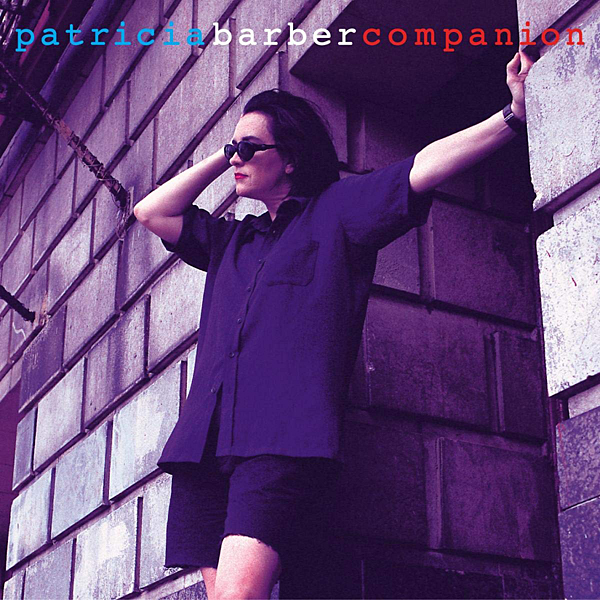
Which reminded me: Hugo had said how, for 40 years, Triangle has worked to improve its paper cones to get those vocals just right. I put on Patricia Barber's "Let It Rain" from her Companion CD (CD, Premonition/Blue Note 5 22963 2), which consists of a pianoless Barber singing alongside John McLean and his acoustic guitar.
First thing I noticed: air. Lots of it. Inside the venue, the crowd, Barber's mouth, around the instruments, there was a lot of breathing room, which consequently created more room for notes to travel, expand, mutate. Nothing sounded choked or stunted but rather fully harmonically developed. A note's initial attack produced a reverberant aftershock that fanned out in a broad arc from the sound's epicenter. Barber's voice was unusually intimate; I'd add whispery if its sultriness wasn't so uninhibited, so I'll add hot instead. But not only in the sense of sexy—I sensed cushions of heat emanating from her breath. And when she beseeches the Lord for rain and implores, "Can't you make those downtown hopping, grocery shopping, perky, plodding, cheerful folks go away," which launches the crowd into what sounds to me like self-conscious laughter, her Ps are potent, hitting that microphone diaphragm like Olivia Newton-John sparring on a punching bag. They were physical.
McLean's guitar plucks sounded alive and right in front of me, in full view. His breathing, the air encircling him, his body movements—there was no mistaking that I was in the presence of a person sitting with an acoustic guitar in his lap, even if I couldn't see him. When he hit his hand on the body of his instrument, the sound exploded in a flashbang of reverberation. Compared to my Focals, the hand booms were less viscerally boomy—there seemed to be less lower-midrange energy—but more harmonically layered.
Similarly, Diana Krall's piano notes in "Dreamsville," from Dave Grusin's Two for the Road: The Music of Henry Mancini (CD, GRP Records CGRD 9865), produced realistically rattling initial attacks then colorful strings of floating notes that wafted like weightless beads in front of me. Krall's voice was balanced so well between its throaty fundamentals and delicate, breathy harmonics that it effectively mapped out her whole head, giving it spectral depth complete with facial sides. Background violin strings were laid out like silk curtains of cascading color.
Another voice well served by the Triangles was Nina Simone's, from the 2021-remastered version of her album Little Girl Blue (CD, BMG BMT867147). Her voice, now anchored between the left speaker and the midpoint between the speakers, was ceiling-high, big-mouthed, fleshy, and anatomically explicit. It was so up close and descriptively etched out that I felt I could see inside her mouth, past her uvula, right to her vocal cords. I couldn't recall Simone ever sounding this vulnerable, her music filled with this much pathos. When she segued into her phrase-ending vibratos, their last, quietest oscillation was as discernible as their first, louder one and more poignant. The tinkling right side of her piano was illuminated in its own self-reflecting halo.
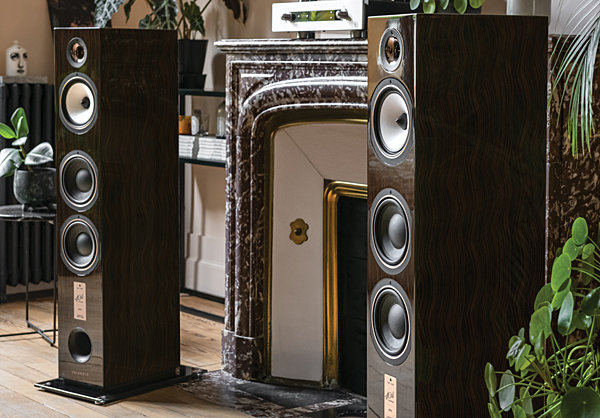
Finally, more vocals, now Don Cherry's Tibet-inspired chants, which bookend the side-long track "Chenrezig" from his album Brown Rice (LP, Horizon SP-717). What the Triangles gave up to the Focals in image height, they gained in focus and detail. Again—and this must be a consequence of the translucence conferred by the Triangles' paper cones—the reverb from his voice, as well as the ringing of the song-opening chimes, paved the air in an array of differently angled echo-lanes, lifting the dark along their lengths. Cherry's trumpet blasts shot like beams of light that electrified the sky. Hakim Jamil's double bass notes rumbled with substance and urgency, while the frantic drum taps, recorded a little anemically here, so they sound more tippity-tap than boom-boom, had body and unrelenting purpose. I imagined Billy Higgins hunched over his drum set, sweat pouring down his face as he refused to let up on that crazy-fast beat for even one second. Frank Lowe's tenor saxophone sounded appropriately honky, husky, and brassy. At times, I got the impression of seeing glimpses of the sax's surface glint as it moved.
La conclusion
At first, the Triangle Antal 40s' presentation destabilized me. Then a moment came when I got them. How much of that was due to break-in or the habituation process, I still can't say. What I can say is that after a few days of listening, my mind has completely bought into the illusion they weave.
The Antal 40's sonic balance is akin to what might be expected if the Focal K2 936s and the Monitor Audio Silver 500 7Gs had a baby, and that baby's main features included a mix of the low-end presence and image corporeality of the Focals with the transient speed and midrange clarity of the Monitor Audios.
The Triangles reveal so much of a note—its tone, pathway, variations, and aftereffects—as to make one note sound like several. Assuming the rest of your system is up to snuff, the Antal 40s will let you hear an inordinate amount of what's on the record. I found it hard to imagine, as I listened, that I was missing anything. I love it when that happens.
For its high level of transparency and vivid timbral colors, the Antal 40s have the spirit of a coral reef. The Antal's paper midrange is a smashing success, well flanked by the performances of the speaker's high- and low-end drivers.
The Triangles lifted me to those high-water–mark, daydreaming states. They became a new frame of reference of what audiophile sound can be.
When I returned to the Focals after a long period of not listening to them, my first thought was that they sounded just a bit bloomy in the lower midrange and dark in the mids. But I knew that told only half the story.

Thank you.
An instant classic review!!!

that "breaks in" is the audiophiles brain. Opinions to the contrary are audiophile nonsense. But there's an aweful lot of audiophile nonsense about everything here so who am I to complain? Whatever you believe is true for you. A lot like religion. If something has no basis in fact then we're all free to believe whatever we decide. It's all good.

Your comments bring this place down. However, my new strategy is to ignore your opinions as I would the ravings of a mad man. Yes this is an ad hominem attack because to even debate what you are being a contrarian about is to stoop too low. A mind like yours cannot accept such abstract concepts. I'm surprised that you can even listen and understand music.

would you accept Klippel factor measurements vs break-in time as proof of brake-in affects? Spider material as much as rubber or whatever the material surrounding the cone measurably change their stiffness & damping properties, especially vs displacement, after having been worked back and forth a couple of (hundred or thousand) times. non-linear properties to plastics isn't really a new thing in science.
See literature on Klippel factors.
PS: it is considerably easier to claim & proof the existence of a particular effect than its universal absence.
best regards
hb72

to get addictive it is necessary that the sound meets the "expectation" you expect from the sound of your hi-fi.

there was someone quite famous in this business who said along the line of , " if you can hear it and it can't be measured than we are measuring the wrong thing." We are all stupid for believing and hearing that audio equipment breaks in but you guys in the white lab coats on audio science review know better than us fools. If that's true, don't go to stereophile to comment just like I dont comment on the audio science review. Keep your opinions to yourself and let us deluded fools us enjoy Stereophile and let us waste our money how we want.

...verges on projection. It wants for traceability and falsifiability, and it contradicts reams of cross-linked, patternable user evidence. It gatekeeps for X what Y may hear. At its best the theory of habituation relies on disconnected assumption and at its worse it abuses and impairs the audio high end.
Together with the myth that things may not break in because reasons, it's another failure of pseudo-reductionism, in this case back down to average sound.
In no field is a phenomenon adamantly disallowed for you until I can prove it to my satisfaction. Just here.

Haven't we heard all these arguments from both sides before? They each fail to convince the other side.
I prefer to take each review at face value, including issues such as this, that inform us of the author's perspective and interpret it in the context of my own perspective rather than throwing out the baby with the bath water.

Funny story happened to me a few weeks ago regarding product habituation. A chap was selling a pair of Linn Kan stands and a recently refurbished pair of Linn Kan I’s. I got the stands and then wondered about buying the Kan I’s. Owning a pair of IIs, I thought it would be fun to do a side-by-side, but I thought better of it than spend $500 on a whim. A week later, he had reduced the price to $350 and told me that Linn purchasers were picky and didn’t want them because he had re-veneered the wood and wasn’t stock looking anymore. He offered to send them to me on his dime and compare them with mine and if I liked them, I could pay him after. When I finally compared them to my II’s I was stunned; mine sounded lifeless; I put my ear to the tweeters to ensure they were working. I checked with companies in the UK, including Falcon Acoustics, about what would cause this, and they think the caps in the crossover were toast. But I realized I was listening to these speakers the last few years, thinking everything was fine when they were slowly declining as performers. The I’s with the new caps, new Falcon Acoustics woofers, and new Hiquaphone tweeters were clearer, more detailed than my ten years younger IIs. Amazing what tricks my brain played on me, always knew I didn’t have golden ears. Time to recap and bring those II’s to full spec.

A room acoustics friend of mine said that the sound of our gear invariably changes due to the constant flow of current running through the components. It's a process that results in altering frequencies and shifting phases, some of which our brain adapts to, some of which it doesn't, and all of which renders the overall sound less involving to us over time.
If it's true, it's a good argument for new or refurbished gear.

If it's true. Does your friend have a reference to any study or investigation of this?

Actually, at this time, to answer your question, Kal, he "more likely does".
This friend works in the industrial acoustic treatment field, mostly to do with soundproofing and lowering room reverberations. He also has his own acoustic treatment business that caters to audiophiles. He mentioned the above theory — those shifting tonalities, frequencies, phases — as being one of the prime reasons why audiophiles, particularly those who never cared about room acoustics before, are now looking for a way to regain their diminished enthusiasm for their system's sound.
And it appears that acoustic treatment can work to this end, because it's designed to compensate for acoustic imbalances. That doesn't mean, however, that it might not be a better idea to just buy something new to replace the old.
I'm sure his work — his passion — is based on scientific evidence, but my gut tells me it's a plausible theory.
I'll ask him for a reference.

There was a guy in my Hi Fi Club who had a major league system, built around some "A" grade equipment.
When I first sat in his room, I thought he had found sonic paradise. Imaging, frequency response, everything.
It had that "live in the same room illusion."
It was perfect, until it started to dawn on me that while it certainly did have all those qualities, it was more like 'live in an eternally unchanging room.'
All the music had that great feeling, but every recording was placed into the same sonic room, over and over.
It wasn't doing anything wrong, but over time I came to dread hearing it.
Everyone's, even Jack L's, system sounds basically the same from day to day....habituation leads to some slight ennui which leads to changing gear. All systems fail that final test of live v recording. At first we may marvel at how close they come, but over time, we tire of hearing the same failure day after day, and we move on.
In general.
Sorry for drifting from the topic of breaking in gear. Breaking us in or breaking us down is also a big part of the hobby, for sure.

This is why I have 3 systems with different characters. A fleawatt SET with full-range open baffles. Then massive Maggies with tube pre and Class D amp. And then mini maggies with class A amp, for near field. Get a little tired of one, go to another.

I believe in your system,exactly.
I had a friend growing up who was like this when it came to dating: the initial rush, habituation, moving on.
Sometimes 'different' is actually what we perceive as 'better.'
Thanks for your great post!